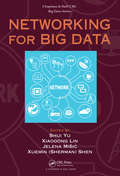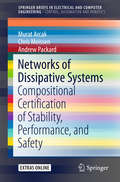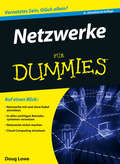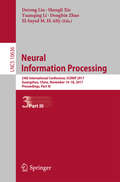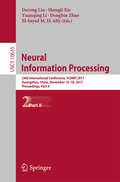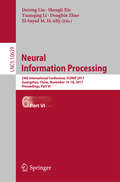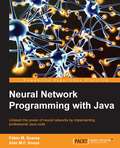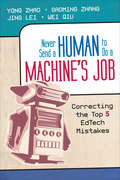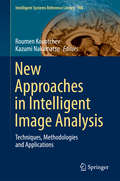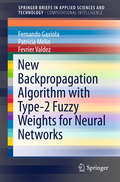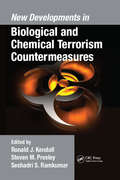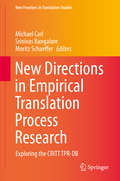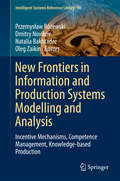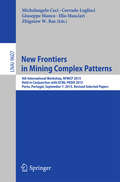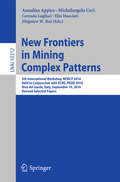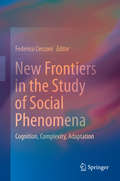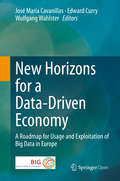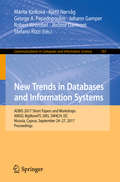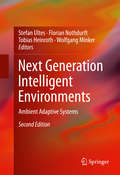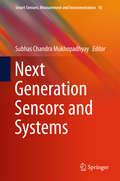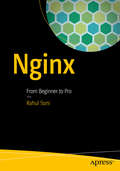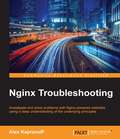- Table View
- List View
Networking for Big Data
by Xiaodong Lin Shui Yu Xuemin Sherman Shen Jelena MišicNetworking for Big Data supplies an unprecedented look at cutting-edge research on the networking and communication aspects of Big Data. Starting with a comprehensive introduction to Big Data and its networking issues, it offers deep technical coverage of both theory and applications.The book is divided into four sections: introduction to Big Data,
Networks of Dissipative Systems
by Andrew Packard Murat Arcak Chris MeissenThis book addresses a major problem for today's large-scale networked systems: certification of the required stability and performance properties using analytical and computational models. On the basis of illustrative case studies, it demonstrates the applicability of theoretical methods to biological networks, vehicle fleets, and Internet congestion control. Rather than tackle the network as a whole --an approach that severely limits the ability of existing methods to cope with large numbers of physical components-- the book develops a compositional approach that derives network-level guarantees from key structural properties of the components and their interactions--the book addresses this problem by pursuing a compositional approach that derives network-level guarantees from key structural properties of the subsystems and their interactions. The foundational tool in this approach is the established dissipativity theory, which is reviewed in the first chapter and supplemented with modern computational techniques. The book blends this theory with the authors' recent research efforts at a level that is accessible to graduate students and practising engineers familiar with only the most basic nonlinear systems concepts. Code associated with the numerical examples can be downloaded at extras. springer. com, allowing readers to reproduce the examples and become acquainted with the relevant software.
Netzwerke für Dummies
by Doug Lowe Gerhard FrankenWollen Sie ein Netzwerk einrichten? Dieses Buch hilft Ihnen bei der Installation, Konfiguration und Administration Ihres ersten Servers, ganz egal, ob Sie ein Heimnetzwerk einrichten oder beruflich als Systemadministrator einsteigen. Doug Lowe unterstützt Sie bei der Entscheidung zwischen LAN und WLAN sowie der Auswahl des Betriebssystems. Und dann geht es ran ans Netz: den Drucker ins Netz bringen, Benutzerkonten einrichten, den Mail- und Web-Server konfigurieren. Das Buch behandelt verschiedene Client-Server-Systeme: Windows, Mac und Linux. Und natürlich geht Doug Lowe auch auf Netzwerksicherheit, virtuelle Maschinen, Cloud Computing und die Integration mobiler Geräte ein.
Neural Information Processing
by Derong Liu Shengli Xie Yuanqing Li Dongbin Zhao El-Sayed M. El-AlfyThe four volume set LNCS 9947, LNCS 9948, LNCS 9949, and LNCS 9950 constitutes the proceedings of the 23rd International Conference on Neural Information Processing, ICONIP 2016, held in Kyoto, Japan, in October 2016. The 296 full papers presented were carefully reviewed and selected from 431 submissions. The 4 volumes are organized in topical sections on deep and reinforcement learning; big data analysis; neural data analysis; robotics and control; bio-inspired/energy efficient information processing; whole brain architecture; neurodynamics; bioinformatics; biomedical engineering; data mining and cybersecurity workshop; machine learning; neuromorphic hardware; sensory perception; pattern recognition; social networks; brain-machine interface; computer vision; time series analysis; data-driven approach for extracting latent features; topological and graph based clustering methods; computational intelligence; data mining; deep neural networks; computational and cognitive neurosciences; theory and algorithms.
Neural Information Processing
by Derong Liu Shengli Xie Yuanqing Li Dongbin Zhao El-Sayed M. El-AlfyThe four volume set LNCS 9947, LNCS 9948, LNCS 9949, and LNCS 9950 constitutes the proceedings of the 23rd International Conference on Neural Information Processing, ICONIP 2016, held in Kyoto, Japan, in October 2016. The 296 full papers presented were carefully reviewed and selected from 431 submissions. The 4 volumes are organized in topical sections on deep and reinforcement learning; big data analysis; neural data analysis; robotics and control; bio-inspired/energy efficient information processing; whole brain architecture; neurodynamics; bioinformatics; biomedical engineering; data mining and cybersecurity workshop; machine learning; neuromorphic hardware; sensory perception; pattern recognition; social networks; brain-machine interface; computer vision; time series analysis; data-driven approach for extracting latent features; topological and graph based clustering methods; computational intelligence; data mining; deep neural networks; computational and cognitive neurosciences; theory and algorithms.
Neural Information Processing
by Derong Liu Shengli Xie Yuanqing Li Dongbin Zhao El-Sayed M. El-AlfyThe four volume set LNCS 9947, LNCS 9948, LNCS 9949, and LNCS 9950 constitutes the proceedings of the 23rd International Conference on Neural Information Processing, ICONIP 2016, held in Kyoto, Japan, in October 2016. The 296 full papers presented were carefully reviewed and selected from 431 submissions. The 4 volumes are organized in topical sections on deep and reinforcement learning; big data analysis; neural data analysis; robotics and control; bio-inspired/energy efficient information processing; whole brain architecture; neurodynamics; bioinformatics; biomedical engineering; data mining and cybersecurity workshop; machine learning; neuromorphic hardware; sensory perception; pattern recognition; social networks; brain-machine interface; computer vision; time series analysis; data-driven approach for extracting latent features; topological and graph based clustering methods; computational intelligence; data mining; deep neural networks; computational and cognitive neurosciences; theory and algorithms.
Neural Network Programming with Java
by Fabio M. Soares Alan M.F. SouzaCreate and unleash the power of neural networks by implementing professional Java code About This Book * Learn to build amazing projects using neural networks including forecasting the weather and pattern recognition * Explore the Java multi-platform feature to run your personal neural networks everywhere * This step-by-step guide will help you solve real-world problems and links neural network theory to their application Who This Book Is For This book is for Java developers with basic Java programming knowledge. No previous knowledge of neural networks is required as this book covers the concepts from scratch. What You Will Learn * Get to grips with the basics of neural networks and what they are used for * Develop neural networks using hands-on examples * Explore and code the most widely-used learning algorithms to make your neural network learn from most types of data * Discover the power of neural network's unsupervised learning process to extract the intrinsic knowledge hidden behind the data * Apply the code generated in practical examples, including weather forecasting and pattern recognition * Understand how to make the best choice of learning parameters to ensure you have a more effective application * Select and split data sets into training, test, and validation, and explore validation strategies * Discover how to improve and optimize your neural network In Detail Vast quantities of data are produced every second. In this context, neural networks become a powerful technique to extract useful knowledge from large amounts of raw, seemingly unrelated data. One of the most preferred languages for neural network programming is Java as it is easier to write code using it, and most of the most popular neural network packages around already exist for Java. This makes it a versatile programming language for neural networks. This book gives you a complete walkthrough of the process of developing basic to advanced practical examples based on neural networks with Java. You will first learn the basics of neural networks and their process of learning. We then focus on what Perceptrons are and their features. Next, you will implement self-organizing maps using the concepts you've learned. Furthermore, you will learn about some of the applications that are presented in this book such as weather forecasting, disease diagnosis, customer profiling, and characters recognition (OCR). Finally, you will learn methods to optimize and adapt neural networks in real time. All the examples generated in the book are provided in the form of illustrative source code, which merges object-oriented programming (OOP) concepts and neural network features to enhance your learning experience. Style and approach This book adopts a step-by-step approach to neural network development and provides many hands-on examples using Java programming. Each neural network concept is explored through real-world problems and is delivered in an easy-to-comprehend manner.
Never Send a Human to Do a Machine's Job: Correcting the Top 5 EdTech Mistakes
by Yong Zhao Dr Gaoming Zhang Jing Lei Wei QiuDo what you do best and let technology do the rest Technology has transformed lives. Why then, has it not transformed education? What needs to change to ensure integration that empowers students and enhances teacher depth? Learn how to let technology cultivate student autonomy, creativity, and responsibility while focusing on lessons that hone higher-order and critical thinking skills. See technology as a complement rather than a replacement Embrace its creation potential over consumption Encourage personalized learning, autonomy, and creativity over outcomes Celebrate digital competence over curriculum improvement Focus on tech-pedagogy over product usage
Never Send a Human to Do a Machine's Job: Correcting the Top 5 EdTech Mistakes
by Yong Zhao Dr Gaoming Zhang Jing Lei Wei QiuDo what you do best and let technology do the rest Technology has transformed lives. Why then, has it not transformed education? What needs to change to ensure integration that empowers students and enhances teacher depth? Learn how to let technology cultivate student autonomy, creativity, and responsibility while focusing on lessons that hone higher-order and critical thinking skills. See technology as a complement rather than a replacement Embrace its creation potential over consumption Encourage personalized learning, autonomy, and creativity over outcomes Celebrate digital competence over curriculum improvement Focus on tech-pedagogy over product usage
New Approaches in Intelligent Image Analysis
by Kazumi Nakamatsu Roumen KountchevThis book presents an Introduction and 11 independent chapters, whichare devoted to various new approaches of intelligent image processing andanalysis. The book also presents new methods, algorithms and applied systemsfor intelligent image processing, on the following basic topics: Methods for Hierarchical Image Decomposition; Intelligent Digital Signal Processing and Feature Extraction; Data Clustering and Visualization via Echo State Networks; Clustering of Natural Images in Automatic Image Annotation Systems; Control System for Remote Sensing Image Processing; Tissue Segmentation of MR Brain Images Sequence; Kidney Cysts Segmentation in CT Images; Audio Visual Attention Models in Mobile Robots Navigation; Local Adaptive Image Processing; Learning Techniques for Intelligent Access Control; Resolution Improvement in Acoustic Maps. Each chapter is self-contained with its own references. Some of the chapters are devoted to the theoretical aspects while the others are presenting the practical aspects and the analysis of the modeling of the developed algorithms in different application areas.
New Backpropagation Algorithm with Type-2 Fuzzy Weights for Neural Networks
by Patricia Melin Fernando Gaxiola Fevrier ValdezIn this book a neural network learning method with type-2 fuzzy weight adjustment is proposed. The mathematical analysis of the proposed learning method architecture and the adaptation of type-2 fuzzy weights are presented. The proposed method is based on research of recent methods that handle weight adaptation and especially fuzzy weights. The internal operation of the neuron is changed to work with two internal calculations for the activation function to obtain two results as outputs of the proposed method. Simulation results and a comparative study among monolithic neural networks, neural network with type-1 fuzzy weights and neural network with type-2 fuzzy weights are presented to illustrate the advantages of the proposed method. The proposed approach is based on recent methods that handle adaptation of weights using fuzzy logic of type-1 and type-2. The proposed approach is applied to a cases of prediction for the Mackey-Glass (for ô=17) and Dow-Jones time series, and recognition of person with iris biometric measure. In some experiments, noise was applied in different levels to the test data of the Mackey-Glass time series for showing that the type-2 fuzzy backpropagation approach obtains better behavior and tolerance to noise than the other methods. The optimization algorithms that were used are the genetic algorithm and the particle swarm optimization algorithm and the purpose of applying these methods was to find the optimal type-2 fuzzy inference systems for the neural network with type-2 fuzzy weights that permit to obtain the lowest prediction error.
New Developments in Biological and Chemical Terrorism Countermeasures
by Ronald J. Kendall; Steven M. Presley; Seshadri S. RamkumarA science-based text, New Developments in Biological and Chemical Terrorism Countermeasures presents research that addresses the growing threat of chemical and biological terrorism as well as the need for improvements in the implementation of countermeasures. This new textbook building upon Advances in Biological and Chemical Terrorism Countermeasu
New Directions in Empirical Translation Process Research
by Srinivas Bangalore Michael Carl Moritz SchaefferThis volume provides a comprehensive introduction to the Translation Process Research Database (TPR-DB), which was compiled by the Centre for Research and Innovation in Translation and Technologies (CRITT). The TPR-DB is a unique resource featuring more than 500 hours of recorded translation process data, augmented with over 200 different rich annotations. Twelve chapters describe the diverse research directions this data can support, including the computational, statistical and psycholinguistic modeling of human translation processes. In the first chapters of this book, the reader is introduced to the CRITT TPR-DB. This is followed by two main parts, the first of which focuses on usability issues and details of implementing interactive machine translation. It also discusses the use of external resources and translator-information interaction. The second part addresses the cognitive and statistical modeling of human translation processes, including co-activation at the lexical, syntactic and discourse levels, translation literality, and various annotation schemata for the data.
New Frontiers in Information and Production Systems Modelling and Analysis
by Dmitry Novikov Przemysław Różewski Natalia Bakhtadze Oleg ZaikinThis book demonstrates how to apply modern approaches to complex system control in practical applications involving knowledge-based systems. The dimensions of knowledge-based systems are extended by incorporating new perspectives from control theory, multimodal systems and simulation methods. The book is divided into three parts: theory, production system and information system applications. One of its main focuses is on an agent-based approach to complex system analysis. Moreover, specialised forms of knowledge-based systems (like e-learning, social network, and production systems) are introduced with a new formal approach to knowledge system modelling. The book, which offers a valuable resource for researchers engaged in complex system analysis, is the result of a unique cooperation between scientists from applied computer science (mainly from Poland) and leading system control theory researchers from the Russian Academy of Sciences' Trapeznikov Institute of Control Sciences.
New Frontiers in Mining Complex Patterns
by Michelangelo Ceci Corrado Loglisci Giuseppe Manco Elio Masciari Zbigniew W. RasThis book constitutes the thoroughly refereed post-conference proceedings of the 4th International Workshop on New Frontiers in Mining Complex Patterns, NFMCP 2015, held in conjunction with ECML-PKDD 2015 in Porto, Portugal, in September 2015. The 15 revised full papers presented together with one invited talk were carefully reviewed and selected from 19 submissions. They illustrate advanced data mining techniques which preserve the informative richness of complex data and allow for efficient and effective identification of complex information units present in such data. The papers are organized in the following sections: data stream mining, classification, mining complex data, and sequences.
New Frontiers in Mining Complex Patterns
by Annalisa Appice Michelangelo Ceci Corrado Loglisci Elio Masciari Zbigniew W. RaśThis book constitutes the thoroughly refereed post-conference proceedings of the 4th International Workshop on New Frontiers in Mining Complex Patterns, NFMCP 2015, held in conjunction with ECML-PKDD 2015 in Porto, Portugal, in September 2015. The 15 revised full papers presented together with one invited talk were carefully reviewed and selected from 19 submissions. They illustrate advanced data mining techniques which preserve the informative richness of complex data and allow for efficient and effective identification of complex information units present in such data. The papers are organized in the following sections: data stream mining, classification, mining complex data, and sequences.
New Frontiers in the Study of Social Phenomena: Cognition, Complexity, Adaptation
by Federico CecconiThis book studies social phenomena in a new way, by making judicious use of computer technology. The book addresses the entire spectrum of classic studies in social science, from experiments to the computational models, with a multidisciplinary approach. The book is suitable for those who want to get a picture of what it means to do social research today, and also to get an indication of the major open issues. The book is connected to a database of code for simulations, experimental data and allows to activate a subscription to a teaching tool using NetLogo, a programming language widely used in the social studies. The authors are researchers with first-hand experience research projects, both basic and applied. The work will be useful for those who want to understand more of the social, economic and political phenomena via computer applications.
New Horizons for a Data-Driven Economy
by Wolfgang Wahlster José María Cavanillas Edward CurryIn this book readers will find technological discussions on the existing and emerging technologies across the different stages of the big data value chain. They will learn about legal aspects of big data, the social impact, and about education needs and requirements. And they will discover the business perspective and how big data technology can be exploited to deliver value within different sectors of the economy. The book is structured in four parts: Part I "The Big Data Opportunity" explores the value potential of big data with a particular focus on the European context. It also describes the legal, business and social dimensions that need to be addressed, and briefly introduces the European Commission's BIG project. Part II "The Big Data Value Chain" details the complete big data lifecycle from a technical point of view, ranging from data acquisition, analysis, curation and storage, to data usage and exploitation. Next, Part III "Usage and Exploitation of Big Data" illustrates the value creation possibilities of big data applications in various sectors, including industry, healthcare, finance, energy, media and public services. Finally, Part IV "A Roadmap for Big Data Research" identifies and prioritizes the cross-sectorial requirements for big data research, and outlines the most urgent and challenging technological, economic, political and societal issues for big data in Europe. This compendium summarizes more than two years of work performed by a leading group of major European research centers and industries in the context of the BIG project. It brings together research findings, forecasts and estimates related to this challenging technological context that is becoming the major axis of the new digitally transformed business environment.
New Trends in Databases and Information Systems
by Mārīte Kirikova George A. Papadopoulos Kjetil Nørvåg Johann Gamper Robert Wrembel Jérôme Darmont Stefano RizziThis book constitutes the thoroughly refereed short papers, workshops and Doctoral Consortium papers of the 20th East European Conference on Advances in Databases and Information Systems, ADBIS 2016, held in Prague, Czech Republic, in August 2016. The 11 short papers and one historical paper were carefully selected and reviewed from 85 submissions. The rest of papers was selected from reviewing processes of 2 workshops and Doctoral Consortium. The papers are organized in topical sections on ADBIS Short Papers, Third International Workshop on Big Data Applications and Principles (BigDap 2016), Second International Workshop on Data Centered Smart Applications (DCSA 2016) and ADBIS Doctoral Consortium.
News: The Politics of Illusion, Tenth Edition
by W. Lance BennettFor over thirty years, News: The Politics of Illusion has not simply reflected the political communication field--it has played a major role in shaping it. Today, the familiar news organizations of the legacy press are operating in a fragmenting and expanding mediaverse that resembles a big bang of proliferating online competitors that are challenging the very definition of news itself. Audience-powered sites such as the Huffington Post and Vox blend conventional political reporting with opinion blogs, celebrity gossip, and other ephemera aimed at getting clicks and shares. At the same time, the rise of serious investigative organizations such as ProPublica presents yet a different challenge to legacy journalism. Lance Bennett's thoroughly revised tenth edition offers the most up-to-date guide to understanding how and why the media and news landscapes are being transformed. It explains the mix of old and new, and points to possible outcomes. Where areas of change are clearly established, key concepts from earlier editions have been revised. There are new case studies, updates on old favorites, and insightful analyses of how the new media system and novel kinds of information and engagement are affecting our politics. As always, News presents fresh evidence and arguments that invite new ways of thinking about the political information system and its place in democracy.
Next Generation Intelligent Environments
by Wolfgang Minker Tobias Heinroth Stefan Ultes Florian NothdurftThis book covers key topics in the field of intelligent ambient adaptivesystems. It focuses on the results worked out within the framework of theATRACO (Adaptive and TRusted Ambient eCOlogies) project. The theoreticalbackground, the developed prototypes, and the evaluated results form a fertileground useful for the broad intelligent environments scientific community aswell as for industrial interest groups. The new edition provides: Chapter authors comment on their work on ATRACO with final remarks as viewed in retrospective Each chapter has been updated with follow-up work emerging from ATRACO An extensive introduction to state-of-the-art statistical dialog management for intelligent environments Approaches are introduced on how Trust is reflected during the dialog with the system
Next Generation Sensors and Systems
by Subhas Chandra MukhopadhyayWritten by experts in their area of research, this book has outlined the current status of the fundamentals and analytical concepts, modelling and design issues, technical details and practical applications of different types of sensors and discussed about the trends of next generation of sensors and systems happening in the area of Sensing technology. This book will be useful as a reference book for engineers and scientist especially the post-graduate students find will this book as reference book for their research on wearable sensors, devices and technologies.
Nginx
by Rahul SoniTeaches you to start up Nginx and quickly take your expertise to a level where you can comfortably work with various aspects of the web server and make informed design decisions for your web farm. Nginx powers more than 40% of the top 1000 websites and is among the handful of web servers that can handle more than 10K simultaneous connections. It has some features which are simply unparalleled. Nginx: From Beginner to Pro teaches the Nginx server in a practical way. Frequently, it is found that web administrators struggle to fix the skill set gaps that happen due to a platform change. Migration from IIS & Apache becomes tedious at best. The book is targeted toward real-world administrators who would want to get up to speed as soon as possible and make good, informed design decisions. First you will set up Nginx and understand the architectural nuances. Then you will learn how to scale out, secure, monitor and troubleshoot the web server. Once you are fully comfortable with Nginx, you will start learning about migrating applications (or its part) from IIS or Apache web servers. Finally, you will learn to troubleshoot and maintain your Nginx professionally. Written by an author who has gone through the rough phase while moving from IIS/Apache to Nginx, this book is practical and filled with step-by-step instructions to make your time with Nginx as straightforward as possible. What You Will Learn Install and set up Nginx on CentOS, Ubuntu & Mac. Understand Nginx modules and compiling Nginx with appropriate modules. Learn about basic configuration and architecture along with hosting nuances. Load balance Nginx and use it as a highly available web platform. Monitor traffic and automate common administrative tasks. Use scripts to perform routine checks for health issues. Implement security and authentication in Nginx. Learn how and what to migrate from IIS & Apache web servers. Who This Book Is For Provides a crisp background of Nginx and then gears towards technical and practical topics. You need to know HTTP protocol, and have basic knowledge of Linux and networking concepts. The target audience is web administrators who would like to learn the finer nuances of Nginx, or map their existing skillset from IIS or Apache.
Nginx Troubleshooting
by Alex KapranoffInvestigate and solve problems with Nginx-powered websites using a deep understanding of the underlying principles About This Book * Solve problems with your Nginx-powered websites before your audience notices anything * Peek into the Nginx architecture and gain knowledge that will help you be valuable to you in the long run * Gain knowledge of different types of problems in a step-by-step way Who This Book Is For The book is for technical specialists who already use Nginx to serve web pages for their users. Whether you are an experienced system administrator or a new professional, this book will help you do your job in the most efficient way. What You Will Learn * Detect and investigate problems with your web servers * Create correct and professional configuration files * Get an in-depth understanding of the web server software * Interpret Nginx log files easily and with actionable insights * Make your websites respond as fast as possible * Prevent problems by setting up proper monitoring and alerts In Detail Nginx is clearly winning the race to be the dominant software to power modern websites. It is fast and open source, maintained with passion by a brilliant team. This book will help you maintain your Nginx instances in a healthy and predictable state. It will lead you through all the types of problems you might encounter as a web administrator, with a special focus on performance and migration from older software. You will learn how to write good configuration files and will get good insights into Nginx logs. It will provide you solutions to problems such as missing or broken functionality and also show you how to tackle performance issues with the Nginx server. A special chapter is devoted to the art of prevention, that is, monitoring and alerting services you may use to detect problems before they manifest themselves on a big scale. The books ends with a reference to error and warning messages Nginx could emit to help you during incident investigations. Style and approach This comprehensive tutorial on Nginx troubleshooting takes an practical approach to guiding you through common issues in Nginx server.
Night Photography and Light Painting: Finding Your Way in the Dark
by Lance KeimigLance Keimig, one of the premier experts on night photography, has put together a comprehensive reference that will show you ways to capture images you never thought possible. This new edition of Night Photography presents the practical techniques of shooting at night alongside theory and history, illustrated with clear, concise examples, and charts and stunning images. From urban night photography to photographing the landscape by starlight or moonlight, from painting your subject with light to creating a subject with light, this book provides a complete guide to digital night photography and light painting.
